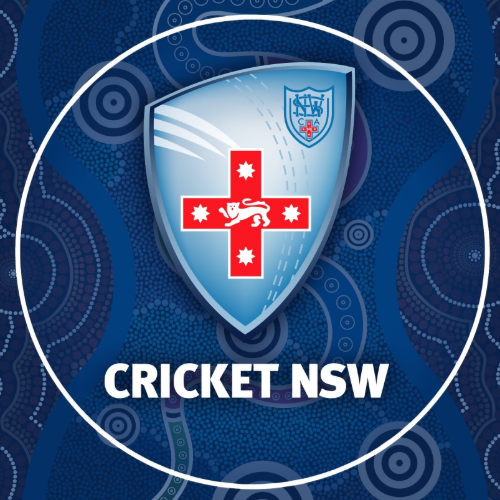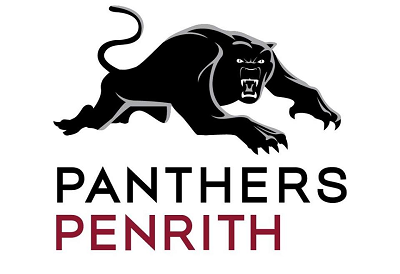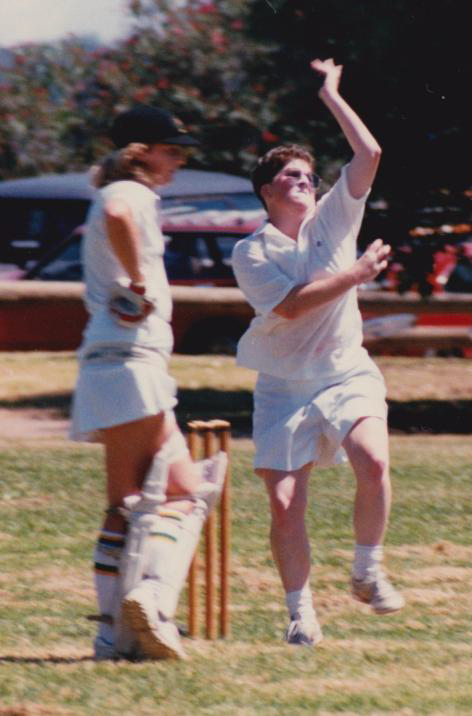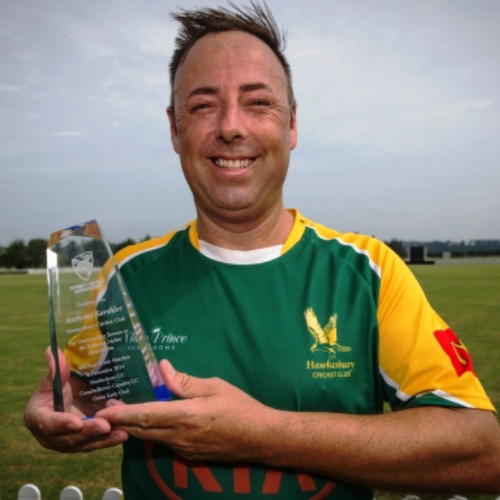A little bit of history was made. For the first time the Club fielded a team in the Sydney Women’s Cricket Association Competition. They competed in the Second Grade. Very few of the girls had played outdoor cricket and the standard was a stiff challenge.But, they were a dedicated bunch moulded by the tireless work of Kim Dolton, on and off the field, and often inspired by the up-front leadership of Bonnie Paniora. More history was written at the end of season when the Club undertook a tour to the United Kingdom. The team management was a volatile mix, with itineraries and social duties being organised by the old swing and seam merchant Ray Hudswell, and tactics and team spirit by the irrepressible Steve Small.
This season fairly reflected the great levelling qualities of the game, sad and glad, good and bad. After finishing seventh in the Club Championship last season, we now slumped to 12th, which was our poorest result since 1980/81. It was a trend-graph heading in the wrong direction. The Firsts finished in the top ten, but the other Grades did poorly. In a sense, it was deja-vu; the Club found itself fighting the same demons that had impacted so negatively in its earliest years—a shortage of experienced players, and the youth, although a valuable commodity, not yet up to speed, which led to a large turnover of players, especially in the lower Grades.
Individually though, the news was brighter than ever. Representative honours were won by Steve Small (NSW/McDonalds Cup), who was named NSW Player of the Season, a wonderful accolade and fitting reward for a cricketer who just loves the game. Other high achievers were Trevor Bayliss (NSW/McDonalds Cup/NSW 2nd XI), Rod Bower (NSW/NSW 2nd XI), Brian Wood (NSW 2nd XI/Colts), Steve Burns (NSW U/17s), Brett Wheeldon (Combined Green Shield captain), Tim Fraser (Green Shield Firsts), and Paul Clarke (Green Shield Seconds).
The Club lost two stalwarts, foundation members Bill Howell jnr., a Patron, and Vice-president Sid Morphett. Bill was the son of William Peter Howell, aka the very famous ‘Farmer Bill’, or, ‘Old Bill’.
Until his death ‘Young Bill’ Howell had a lifetime association with cricket. He played for NSW on 14 occasions—a member of the Cumberland Club (later to become Parramatta)—and played in the local Nepean DCA into his fifties. He was a regular face at the Club’s Howell Oval matches. Sid Morphett was a keen Club and Nepean DCA supporter and the proud father of sons Ray, John and Rodney(#), who created the unique record of all playing together in Penrith’s First Grade team in the Club’s first season 1973/74.
The Club saw some talented acquisitions—Rod Bower from Bankstown, Tony Cottey and Phil North from Glamorgan (English County Cricket), Mark Sargent from Parramatta, Craig Bayliss, brother of Trevor, from Goulburn and Tim Fraser from Dungog.
Penrith Panthers are proud sponsors of Penrith Cricket Club
First Grade (8th-44pts)
First Grade’s frustrating season was highlighted in the Club Secretary Bill Ball’s Management Committee report: “Our Firsts suffered from the rule which allowed teams to bat into the second day. Our batting line-up was held in awe by many teams, and as a result (opponents) often batted well into the second day, with many drawn matches resulting.”
The line-up included three State players: Steve Small, Trevor Bayliss and Rod Bower. Twice, Penrith had three players in the NSW team, which was a proud achievement for the Club, but it did bring us back to the field in the matches they missed. There were 23 scores of 50-plus, including one 200 and eight 100s.
Rod Bower was a run machine. Captain Ken Hall in his season report, noted: “Our bowling attack suffered this year—no Phil Blizzard, and, our strike bowler Mark Denny was injured for periods throughout the season.” In the separate Limited-overs competition the team lost to Campbelltown, eventual Premiers, in the Semi-final.
Highlights
- Rod Bower scored 702 runs @ 78.00 (Club Record Average), including 200 v Hawkesbury 114 v North Sydney, 107* v Waverley and 65 v Manly
- Brian Wood scored 487 runs @ 40.50, including 100* v Parramatta, 92 v North Sydney, 62 v Mosman and 53 v Sutherland; passed 3,000 runs for the club
- Ken Hall scored 382 runs @ 42.44, including 123* v Fairfield and 103* v Hawkesbury; took 25 wickets @ 28.76, including 5/30 v Waverley; took 19 catches
- Steve Small (eight innings) scored 369 runs @ 46.12, including 121 v Hawkesbury, 75 v Campbelltown and 61 v Sutherland
- Trevor Bayliss (nine innings) scored 364 runs @ 52.00, including 79 v St George, 69 v Fairfield, 62* v Uni NSW and 62 v Randwick
- Tony Cottey (five innings) scored 256 runs @ 51.20, including 115 v St George and 51 v Manly Mark Sargent scored 91 v Parramatta, his old Club
- Mark Denny took 30 wickets @ 28.43, including 5/51 v Hawkesbury
- Mick Haire took 28 wickets @ 27.82, including 5/39 v Gordon
- Greg Gavin scored 64 v Manly; took 26 catches, made three stumpings
- Rod Bower and Ken Hall set a new Club Record 4th Wicket Partnership of 190 v Hawkesbury
Set a new Team Club Record score of 4/447 v Hawkesbury (Bower 200, Small 121 and Hall 103*). A challenge for future First Graders
Runs for: 3425 Wickets lost 92 Average 37.34
Runs against: 3726 Wickets taken 126 Average 29.57
Second Grade (16th-30pts)
The gay deceivers! Captain Ray Hudswell in his season report, noted: “Thirty points in a Grade cricket season is hardly a great performance, yet 30 points at one stage looked impossible. After tailing the Second Grade table for almost three-quarters of the season, Seconds won four of the final five matches, to at least show what may have been.”
The loss of top-order batsmen Grant Woodbridge, returned to Canberra, and Wayne Holt back to his grass roots at Hawkesbury, caused teething problems for the top order. Twenty-three players played Seconds, the most since the dark days of the 70s.Hudswell concluded his report thus: “Nothing is ever a disaster as long as you learn from it. Let’s look at this season and accept it for what it was (bloody awful!) and let’s make sure it doesn’t happen again.”
Highlights
- Ian Redpath scored 470 runs @ 33.57, including 94 v North Sydney, 72 v Uni NSW, 69 v Northern District, 58 v Waverley
- Jason Penrose scored 413 runs @ 25.81, including 99 v St George, 55 v Fairfield and 51 v Campbelltown; took 12 catches
- Mark Sargent (eight innings) scored 310 runs @ 44.29, including 100 v Gordon and 64 v Manly
- Michael Wholohan scored 303 runs @ 27.55, including 58 v Campbelltown; took 14 catches, made one stumping
- Graham Price (three innings) scored 153 runs @ 51.00, including 74 v Sutherland, 66 v Randwick
- Tony Cottey (six innings) scored 177 @ 29.50, including 52 v Manly
- John Saint took 26 wickets @ 21.21, including 7/73 v Manly
- Mark Butler took 21 wickets @ 21.23, including 5/46 v Gordon
- Tony Kershler took 16 wickets 16.75, including 5/38 v St George
- Phil North took 16 wickets @ 31.18, including 5/112 v Sutherland; scored 54* v St George
- Paul Thomas took 5/70 v Fairfield
- Jason Penrose and Phil North set a new Club Record 8th Wicket Partnership of 117 v St George
Runs for 3316 Wickets lost 156 Average 21.25
Runs against: 3246 Wickets taken 128 Average 24.59
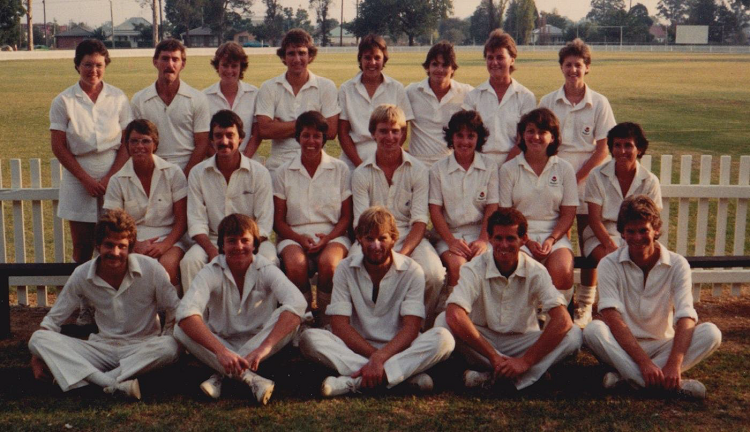
When The Women joined the Men for a Match at Howell—
Back Row (l to r) Trish Dawson (Senior Woman), Mark Oliver, Sally Moffatt (Junior Woman), Barry Coad, Debbie Wilson (JW), Brian Wood, Jenny O’Donnell (JW), Sally Griffiths (JW); Centre: Ann Mitchell (SW), Barry Clarence, Bev Wilson (SW), Mark Gouldstone, Denise Annetts (JW), Sue Fietz (JW), Jackie Potter (SW); Front: Richard Harvey, Michael Wholohan, Paul Thomas, Rod Evans, Tom Shiner. The date was March, 1983.
Third Grade (15th-34 points)
The Third’s run of four straight Semi-final appearances came to an end, but captain Ron Halse, in his season report, noted: “I saw enough of these young and inexperienced players to confidently predict that they will form the nucleus of Penrith Grade cricket teams for many years to come, above average cricket teams at that.
The loss of Lawrie Renshall, Peter Savage, Charlie Doyle, Rob Sneddon, and the promotion to Seconds of John Saint and Greg Sheens from last season, left a big gap. However as the season progressed their young replacements, 17-year-old Steve Burns, 15-year-olds Brett Wheeldon and Andrew Crawford, Derek Arnberger, Craig Gunton, Pasco Skelin, and Ian Schofield, came to the fore.” There was mention too, from the captain, of what is a vital ingredient in any cricket club’s fabric, and, it can lead to success, it builds spirit.
He closed off with this: “Thanks also to Mrs Halse (wife) and Mrs Halse (mother) for organising eats at home games.” Essentially, he was underlining the importance of women in the Club. The disappointing news would be that by the commencement of the second decade of the new century (2010/11) that vital part of the Club’s ethos was in obvious need of resuscitation.
Highlights
- Geoff Bannister scored 258 runs @ 32.25, including 78 v Randwick and 67 v North Sydney
- Craig Gunton scored 237 runs @ 23.70, including 66 v St George and 51 v Waverley
- Vince Higgins scored 207 runs @ 41.40, including 92 v Mosman and 63 v Manly
- Steve Hider (seven innings) scored 201 runs @ 33.50, including 103 v Randwick and 83* v Parramatta
- Pasco Skelin scored 201 runs @ 33.50, including 50 v Sutherland; took 12 wickets @ 28.75, including 5/61 v Campbelltown
- Steve Burns scored 169 runs @ 21.12, including 57* v Waverley
- Brett Wheeldon (five innings) scored 156 runs @ 26.00, including 55 v North Sydney; captain of the AW Green Shield
- Andrew Crawford (from 59 overs) took nine wickets @ 13.33, including 6/47 v Randwick; played AW Green Shield
- Steve Hider and Ashley Aviet set a new Club Record 10th Wicket Partnership of 110 v Parramatta
- Andrew Crawford (from 59 overs) took nine wickets @ 13.33, including 6/47 v Randwick; played AW Green Shield
- Ian Schofield and Steve Hider set a new Club Record 9th Wicket Partnership of 134 v Randwick
- Steve Hider and Ashley Aviet set a new Club Record 10th wicket partnership of 110 v Parramatta
Runs for 3335 Wickets lost 123 Average 27.11
Runs against: 2821 Wickets taken 103 Average 27.38
Fourth Grade (13th-36 pts)
Captain Jon Llewelyn in his season report, noted: “With the loss of approximately a full team of experienced players up the Grades during the off season, the Club was unable to find enough experienced players to guarantee depth of strength.” John did some sums: “If I excluded myself from the team average age calculation then it worked out at a tick under 17.” During the season 32 players made appearances with the Fourths.
Highlights
- Tony Beacroft scored 366 runs @ 30.50, including 75 v Campbelltown, 59 v Sutherland and 56 v Fairfield
- Hratch Sekzenian scored 256 runs @ 23.30, including 76 v Parramatta
- Ian Schofield scored 230 runs @ 23.00, including 52 v Mosman
- Andrew Crawford scored 220 runs @ 24.40, including 56* v Mosman
- Andrew Bridge (four innings) scored 218 runs @ 72.70, including 111 v Parramatta
- Jon Llewelyn took 21 wickets @ 19.20, taking his total wickets for the club to 399
- Mark Freeman took 15 wickets @ 16.60, including 8/38 v Uni NSW
- Ashley Aviet took 5/32 v North Sydney
- Andrew Bridge and Hratch Sekzenian set a Grade Record 5th Wicket Partnership record of 140 v Parramatta
Runs for: 2896 Wickets lost 139 Average 20.83
Runs against: 2962 Wickets taken 133 Average 22.27
Fifth Grade (14th-36 pts)
Fifth Grade captain Tom Lavelle ‘met’ 29 players during the season. Two names would remain prominent into the future. Kevin Chevell (5/44 v Randwick) opened a successful gym and fitness centre in Penrith, and among his ‘clients’ were Mark Taylor and Glen McGrath.
Michael McGuire (5/21 v Hawkesbury) would become a stalwart in the development teams, Fifths and Colts, in the first decade of the new century.
Highlights
- Alan Harper (seven innings) scored 204 runs @ 34.00, including 83 v St George and 56 v Waverley
- David Ellison (six innings) scored 163 runs @ 40.00, including 100 v Manly
- Robert Killian scored 203 runs @ 25.40, including 61 v Manly
- Glen Bootle scored 110 runs @ 36.60, including 57 v Northern District; took a hat-trick v St George
- Darrian Doherty scored 55 v St George; took 11 wickets @ 19.70, including 5/37 v Waverley
- Mick Maguire took 11 wickets @ 9.27
- Glen Neal took 10 wickets @ 25.70, including 6/30 v Parramatta
- Alan Harper and Mark Freeman set a Grade Record 2nd Wicket Partnership of 84* v Waverley
- Mark Freeman and Rob Killian set a Grade Record 3rd Wicket Partnership of 92* v Manly
- Dave Ellison and Steve Mitchell set a Grade Record 9th Wicket Partnership of 102* v Manly
Runs for: 2349 Wickets lost 122 Average 19.16
Runs against: 2518 Wickets taken 121 Average 20.81
Sixth Grade
Captain David Cole, in his season report, noted: “Thrown into the Nepean DCA Second Grade Competition with a team of kids, not knowing who did what, and, to finally just miss out on the Semi- finals made it all worthwhile, and an enjoyable season.” There was an historic moment: a 13-year-old schoolboy, Jason Arnberger, turned out with the team. Historic for Penrith but not uncommon at older Clubs—Arthur Morris played First Grade for St George at 15, and Bob Simpson, Petersham- Marrickville, was 16 when he played for NSW. Arnberger would subsequently play First-class cricket for both NSW and Victoria, thus becoming the first locally-produced player to play for the State. His presence in Sixths merely confirmed that the value of playing any very talented youth among the men cannot be overstated. Possibly to captain Cole’s relief, a former First Grader, Gary Harper, joined the team mid-season to help out with the youngsters.
Highlights
- Ian Stubbs scored 273 runs @ 22.75, including 80 v Colyton and 63 v Penrith RSL
- Wayne Roth scored 226 runs @ 25.11, including 80 v Colyton; promoted to Fifths
- Brad Lodge scored 210 runs @ 17.50, including 58 v Springwood and 52 v Werrington
- Alan Harper scored 195 runs @ 24.37, including 71 v Bowling Club; promoted to Fifths
- Gary Harper scored 106 v Werrington
- David Ellison scored 104* v Colyton; Green Shield player promoted to Fifths
- Jason Arnberger scored 101 runs @ 20.20, including 50* v Springwood
- Wayne Irwin took 27 wickets @ 20.81, including 8/42 v Colyton and 5/72 v Leagues
- Darrian Doherty took 25 wickets @ 14.40, including 6/90 v Colyton and 5/53 v Penrith RSL
Runs for: 2376 Wickets lost 112 Average 21.22
Runs against: 2261 Wickets taken 115 Average 19.65
Poidevin-Gray
Ron Halse was a frustrated manager. “Two wins, two losses and a draw was an improvement on the previous season ... but with the experience of the previous season behind them, and a wealth of talent throughout the team, not the anticipated result. Wins against the highly fancied Bankstown and Western Suburbs showed we were the equal of any team in the competition.” An unusual aspect to the team was the presence of Tony Cottey, a young Welshman.
Highlights
- Tony Cottey scored 180 runs @ 45.00, including 60 v Wests, 57 v Petersham and 54 v Balmain
- John Saint scored 115 runs @ 57.50, including 51* v Petersham; took nine wickets @ 21.55, including 6/80 v Wests
- Pasco Skelin took 12 wickets @ 17.25, best 4/22 v Bankstown
- Greg Sheens took 12 wickets @ 24.91, best 4/65 v Bankstown
- Michael Wholohan took 10 catches, a record for a keeper in PGs
- Tony Cottey and Derek Arnberger set a Record 1st Wicket Partnership of 96 v Petersham
Runs for: 829 Wickets lost 32 Average 25.90
Runs against: 860 Wickets taken 38 Average 25.70
Green Shield
Manager Keith Martin thought this was the best balanced team to take the field in the three years that he’d been associated with the Club’s Green Shield teams, and its success bore that out. “Our last match was against Sutherland and we had to win to get into the Final.” It was a thriller. Penrith, after being 3/90 on a pitch that spun like a top crashed to be all out for 121. Sutherland wobbled but got them seven down.
AW Green provides the entrée for many young players to progress to the higher Grades, and into the elite State age teams, U/17 and U/19; Brett Wheeldon and Andrew Crawford played Thirds and PGs, Dave Ellison and Alan Harper played Fourths, Darrian Doherty and Paul Martin Fifths. Brett Wheeldon and Tim Fraser were selected in the Combined Green Shield Ones, Brett as captain. Brett top scored with 44 in the match against the Combined Country Coaching Class XI, a useful traditional arrangement that for many years boosted youth cricket.
Highlights
- Brett Wheeldon scored 317 runs @ 52.83, including 84 v Fairfield and 76 v Hawkesbury
- Paul Clarke scored 243 runs @ 48.60, including 103* v Fairfield and 63* v Bankstown
- Alan Harper scored 209 runs @ 29.85, including 75 v Bankstown and 62* v Wests
- Andrew Crawford scored 200 runs @ 25.00, including 57 v Parramatta and 56 v Hawkesbury, took 13 wickets @ 14.46, including 5/41 v Sutherland
- Tim Fraser took 20 wickets @ 13.75, including 6/41 v Parramatta and 5/48 v Fairfield
- Darrian Doherty and Stephen Neale set a Grade Record 9th Wicket Partnership of 48 v Campbelltown
Runs for: 1481 Wickets lost 53 Average 27.94
Runs against: 1188 Wickets taken 70 Average 16.97
ROD BOWER
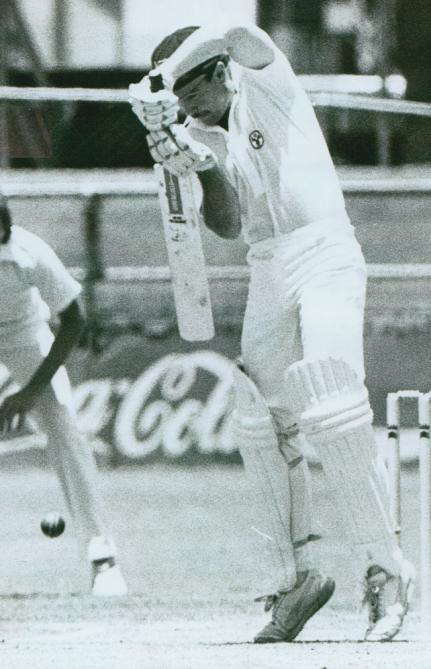
When Rod Bower came to Penrith from Bankstown his aggressive stroke play had already impressed the State selectors. He had played Colts and 2nd XI and had made his Sheffield Shield debut against Tasmania at the SCG in the 1983/84 season. Batting at No.4 he scored 31 not out and, coincidentally, when out for 21 in the second innings he was caught from the bowling of Peter Clough, the former Penrith fast bowler. Early next season he had the daunting experience of facing the famous, fiery, fearsome Jeff ‘Thommo’ Thomson, an ex-Bankstown boy, on a ‘Gabba greentop, yet he was probably the last man never to wear a helmet in any circumstance at any level.
At stance he was an imposing figure, square shouldered, feet planted wide enough apart to remind watchers of Dean Jones. He was a strong, hard striker of the ball who could devastate a Grade attack. His double-century against Hawkesbury at Howell broke Steve Small’s record. The dismissal was as brilliant as the innings—he was caught by ex- Penrith player Wayne Holt, who made a running, diving catch at long-on just before the ball hit the fence in front of the pavilion.
In 1986, Rod toured Zimbabwe with a NSW team that included Penrith’s Bayliss and Small. Bayliss tells this story: “Bower, Small, Bob Holland and Greg Dyer were walking back to the team bus along a dry dirt track away from the edge of Victoria Falls. They spied a good photo opportunity, a female baboon and baby up in a tree, not 20 metres off the track. Wanting a close-up photo, the boys slowly and carefully picked their way through the long- thorned briar bushes until they were positioned directly underneath the tree and the baboons. Unfortunately for them they hadn’t noticed the six-foot male baboon standing behind the tree. He stood up, raised his arms above his head, let out a huge roar and chased them. Never had the rest of us seen these four move so quickly. When they reached us it was quite obvious they had paid no heed to the briar bushes—their legs were cut to pieces and bleeding. A great laugh for the rest of us.”
Rod’s last Shield game was at the Adelaide Oval in 1987. First-class career: 13 matches, 22 innings, 421 runs, average 22.15. His highest score was 63 against Western Australia.Rod’s Bankstown team-mates had nicknamed him ‘Log’ (tree connotation, Bower = bough = wood = log) but at Penrith he was simply ‘Loggie’. For Penrith, he scored 3395 runs @ 41.40, and took 44 catches from 1986/87 to 1991/93.
In retirement he retained his interest in the game, coaching local juniors in batting skills. He and his wife Debbie took up the game of polo, plying their talent at the Windsor Polo Grounds on Bells Line of Road.
LAWRIE RENSHALL
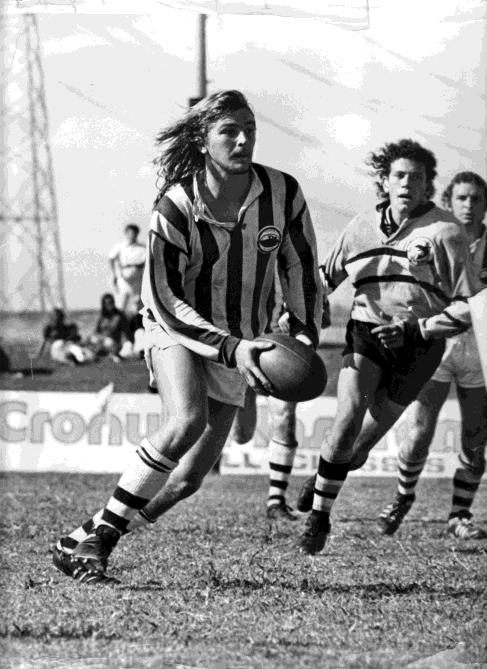
There were four ‘unlucky’ captains during the Third Grade’s frustrating, but nevertheless remarkable run of Semi-final appearances. They were Lawrie Renshall, Tim Sullivan, Ron Halse and Geoff Bannister. Longest-suffering was Renshall, a larger-than-life character whose sporting references tell the tale of an era sadly no more, when it was acceptable to enjoy more than one sport at the elite level. Football may have been his first love, but it bruised his second love, cricket. Undoubtedly, his cricket had great potential. He was cocky, or confident, take your pick, although the wicketkeeper whose record he broke early in his career at Cumberland, Daryl Smith, would say he had ‘presence’.
The Cumberland-Penrith Connection(#) is a long, and, rich one. Cumberland (now Parramatta) historian Tom Wood remembers young Renshall in Third Grade in the 1969/70 season ... “fine anticipation, excellent hands and very long hair”. He started the 1970/71 season late, due to a football injury. In 1971/72, and still at school, he celebrated his First Grade debut by breaking the Season Most Dismissals Record, once taking six catches in a match against Sutherland, in fact the first six to fall before lunch! In Adelaide for the National U/19 Championships, he rubbed shoulders with the great David Hookes, who was only 16, and Peter Toohey, both of whom would play for Australia.
In 1973 he left Cumberland for Penrith—but to play Rugby League! He captained the Panthers Under 23s, which contested the Semi-finals. He was regarded as a tough front-rower, a clever ball-handler, and a cool goal- kicker. In a match against Cronulla the Panthers crossed for a try on fulltime, score Cronulla 7-6. Lawrie’s conversion after the bell made it 8-7. Suddenly, his sporting career went belly-up, a knee badly busted in a League trial. His cricket drifted, a stint of A-Grade in the park his only interest. He started building a career in school teaching. In 1980 he was appointed an assistant coach of Penrith Panthers First Grade, and returned to Penrith cricket in 1981/82 as Seconds vice-captain. Next season he was in Thirds, and captain, and, in cricket’s elevator, penthouse one moment, basement the next.
He recalls a few career moments: “In Seconds at North Sydney No.2 hit three sixes over the 8m-high-wire fence onto the Bradfield Highway, not a turning point but turned some heads. Watched Trevor Bayliss keep in First Grade—could have been the ‘first Adam Gilchrist’, he was that good.
Thirds played Randwick in the Semi in 1984/85. We were all out for around 110. Had Randwick 9-100 when I took a catch off a no-ball. Should have won. Lost. In the 1985-86 Semi we were 8-323 from our ‘maximum’ 110 overs. Had NDs 5/120 and I dropped a catch, the new batsman who hadn’t scored. He ended up with 120 odd runs and they beat us seven wickets down with four overs to spare.” Lawrie wound down his cricket career at Hawkesbury from 1986-89 as a lower Grade captain. His teaching career took him from Seven Hills West Public to Principal at Nana Glen, via schools at Rooty Hill, Leonay, Blackett, Cedar Mill Elementary in Oregon, USA, and Urunga, which in 1994 won the State Soccer Championship from 420 other schools, Lawrie coaching.
A final word on his ‘soft hands’: when at Blacktown Boys’ High School in Year 12 in 1971, fellow pupil Warren Lees threw an egg 272 feet three inches and Lawrie caught it, a world record. It was an item on Channel Nine’s Paul Hogan/’Strop’ Cornell show.
MALTHOID, MATS AND MISSES
As has been recorded in Chapter One, at the beginning of the 80s decade there were matches played between men and women at Howell Oval, the idea being to promote Women’s cricket. Three summers would pass before Women’s cricket would get stand-alone status at Penrith. And, the catalyst was a unique mix of indoor cricketers, a brainwave, and the administrative skills of one woman, Kim Dolton.
Kim Dolton, the youngest of six children, four of them big brothers, was raised at Chester Hill in a fibro house ‘of the times’, the 60s. It turned out that she, and none of her brothers, would be the cricketer. At Sefton High School she was encouraged by Patsy May, a teacher who had played for Australia at both softball and cricket. Patsy bowled tidy outswing, and, in 1976 aged 29 played against England at Lord’s, taking the first wicket. Miss May also coached, and, one weekend asked Kim to fill in for her Second Grade team. Kim recalls: “I was 13 years old. I packed the culottes (knee-length trousers resembling a skirt) and a polo shirt. We played on an oval near The Oaks at Neutral Bay.”
Yet, it would be indoor cricket, whose popularity surged in the 80s, which would provide Kim, and a host of other young women, with an opportunity to seek success in the outdoor game. They played the indoor circuit at centres as widespread as St Marys, Girraween, Gladesville and Fairfield. “We were playing six nights a week,” Kim recalls. “Maybe it was too much, maybe we were getting a little bored, I don’t know, but a couple of us said, why not form a team to play outdoor cricket?”
And so Kim, a more-than-handy cricketer, became the driving force behind the establishment of the first Women’s teams at Penrith. She recruited from all the indoor teams, got the numbers, and John Rennie and Greg Gavin advised her to seek out Bill Ball for guidance. She did all the paperwork, established the link to the Sydney Women’s Cricket Association which gave them Second Grade status, attended the SWCA meetings, organised the registrations, drove the Ford Falcon wagon, “packed with girls and gear” to games.
Our ‘first ladies’ were Bonnie Paniora (captain), Jenny Webb, Elaine Thomas, Karen White, Kim Dolton, Kathy Matena, Alison Schaefer, Jackie Dyson, Jackie Brown, Mel Walters, Laura Foglia, Wendy George, Maria Dyson, Jo-Anne Malone. Maree Rennie helped out.
Their main home ground was Weir Reserve, near the Nepean Rowing Club. The pitch was malthoid. “On a hot day there were trees to sit under, but the tar (malthoid) would melt and stick to the ball,” Kim remembers. Matches were also played at Monfarville on green coir matting, and sometimes on concrete at Cranebrook, elsewhere ‘astroturf’. Kim: “In that first season the only turf pitch we played on was ‘The Square’ at Sydney Uni. We had to umpire our own games, although in later years, when we made the Finals, we did have official umpires.”
Kim remembers those early days: “I thought we had a good batting and bowling line-up; we just didn’t quite win as many games as we thought we were going to. We only won one match. We had the skills but we had to adapt from indoor. There was not a great deal of coaching for us, and, quite frankly we couldn’t do much training. Most of us had jobs in the city. Our training was indoors, sometimes a single net at Howell Oval, one situated next to the curator’s shed. Even though we were getting flogged nobody wanted to drop out. As time went on we would lose players because we were not in the First Grade. Our best players were snapped up.” Any of that male chauvinistic stuff? “Not a bit. We were well received at Howell and used to go back there after our home matches for a drink and to socialise. If we were playing away then we’d go to a nearby pub.”
In ensuing seasons the team would be re-graded and win Premierships, yet the rough patches were ever-present. In 1988/89, Kim said in her report: “I am appealing to all players and members if they know of any likely new players to let me know as we urgently require them for the coming season”. Kim would join the Management Committee at Penrith where her contribution was invaluable. Ray Hudswell: “She made an immediate impact by keeping the rest of us on task. She had the ability to control the testosterone levels within the room and was a delight to work with.” When she gave birth to a son, David, she took him along to a presentation night and, at the age of two months, the Club presented him with miniature batting gloves and pads. Kim later took her administrative skills to Indoor Soccer. She is a printer by profession with Blacktown Image Print.
HISTORY IN THE MAKING
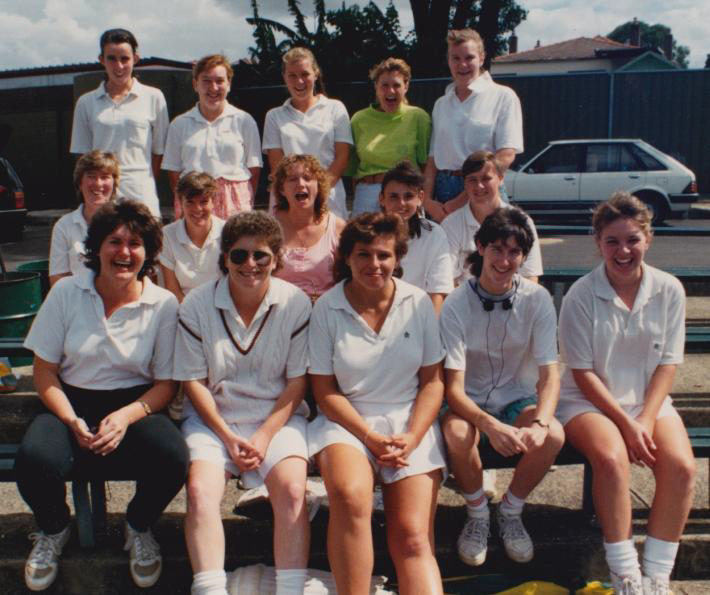
This spread of photos encapsulates the early days of the groundbreaking move of the Club into Women’s Cricket. Some Of Our First Ladies. Left, in the front row, from left to right, are Kim Dolton, Elaine Thomas, Anne Peters, Jo-Anne Malone and Samantha Richardson. In the middle are Kristen Burke, Rebecca Sharpe, Sharon Pepper, Sharmaine Smith and Debbie Wright. In the back row, on the left are Narelle Clines and Jenni Bates. Alas, time has blurred the memory and the names of the three girls on the right of that row remain a mystery. All Action. The aggressive bowling style of the remarkable Elaine Thomas, who would have such success it would not be out of place to describe her as the ‘Ken Hall’ of early Women’s teams.
FIRST SEASON HIGHLIGHTS
The Women, well led by all-rounder Bonnie Paniora—“she could throw it down fast”—struggled but showed enough flashes of form to raise high hopes for the future. Losing star bat Kathy Matena to a severe knee injury at Round three was a major blow.
- First win: Uni NSW (Penrith 187, White 73, Schaefer 22, Dolton 20; Uni NSW 141, Paniora 4/25, Dolton 3/28, J Dyson 1/28)
- First century: Kathy Matena 122* v YWCA
- First 50: Karen White 73 v Uni NSW
- First five-wicket haul: Bonnie Paniora 5/8 v Uni NSW
- First century partnership: Kim Dolton and Kathy Matena, 100 in 75 minutes v YWCA
- Kathy Matena (three innings) scored 135 runs @ 67.50
- Bonnie Paniora scored 222 runs @ 18.50, including 50 v Randwick; took 18 wickets @ 13.27
- Karen White scored 176 runs @ 19.55, including 57 v Campbelltown
- Elaine Thomas took 23 wickets @ 15.91
Runs for: 1686 Wickets lost 142 Average 11.87
Runs against: 1835 Wickets taken 83 Average 22.10
THE LUCK OF THE GAME
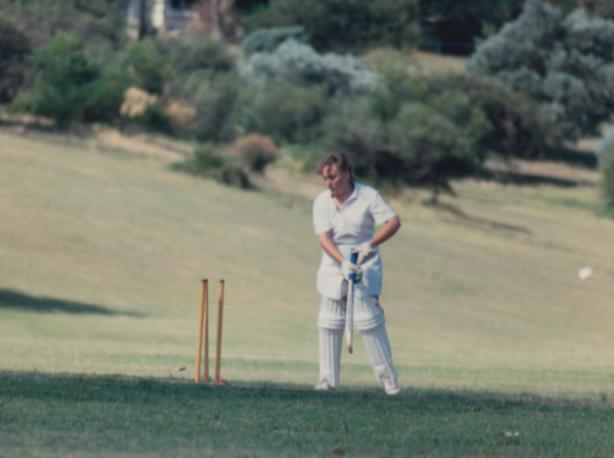
The scoreboard told the toughness of the Women’s first season, but these photos show the highs far outweighed the lows. The Loneliest Feeling. Left, Jenni Bates surveys the ‘wreckage’, a stationary red ball at the base of broken stumps, victim of an unplayable one on the ‘astroturf’ at Queens Park.
Whack! Below, Penrith’s Alison Schaefer on the lookout for quick runs against University at Weir Park. The umpire, in pink shorts, is Bonnie Paniora, the star all-rounder in the team’s first season.
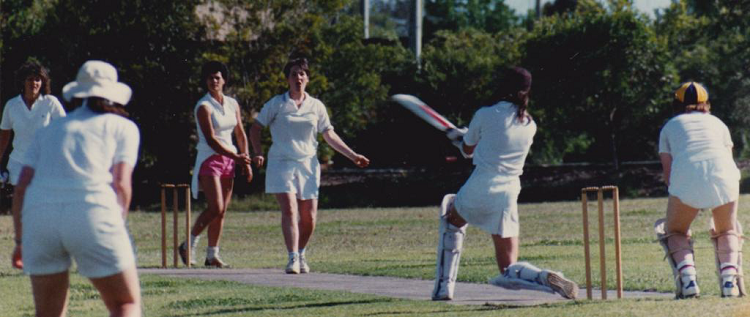
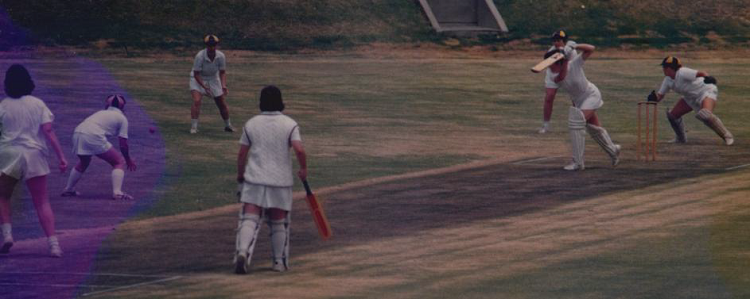
Straight Out Of The Text Book. And, it’s great cricket action ... all eyes on the ball, note the keeper on the move. Above, Kim Dolton plays a classical front foot drive under the watchful eye of Elaine Thomas against University on the turf at The Square. Just look at that high elbow and bent front leg! And, she’s found the gap in the field. Right, with bat poised and eyes focused it’s Jackie Dyson preparing to go on the attack on the malthoid at Weir Reserve.
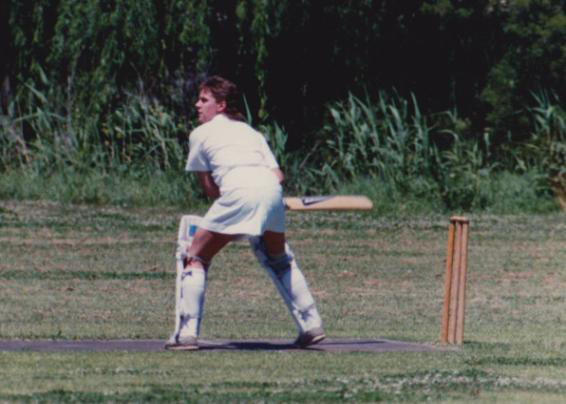
THE MIXED MATCHES
The concept blossomed in the late 70s and early 80s after a woman cricketer, Tina McPherson, had been a spectator at a social cricket match involving the Swire Travel XI, a group of ex- International, Grade and Shire players organised by Frank Clark, who loved his cricket, spent time as a delegate to the NSWCA, and, introduced a Swire Rookie Of The Year Award to the Penrith Club.
Urged on by Tina, Frank approached Lorna Thomas, who was a senior official in the NSW Women’s Cricket Association, and the first matches between men and women were played at Petersham Oval. One match ended in a tie, and received good national media coverage. “The ladies were as pleased as punch,” says Frank, who—naturally—was asked to organise other mixed matches. “When arranging a game I always told the men to take things a little easy and not to go all out and try to prove how macho they were. Mostly it worked and all the games were played in a good spirit,” says Frank. Penrith’s Clarence brothers, all-rounder Bob and keeper Barry, and left-arm quick Glen Dixon played in some of the Petersham Oval matches. Bob remembers: “Glen forgot the ‘macho warning’ and terrified them; the ladies were brilliant in the field, extremely keen, Jackie Potter a standout; Debbie Wilson was a class fastish medium, got to the crease well and good over-the-top action; Denise Annetts was a helluva good opening bat.”
When Frank Clark came to Penrith he brought the concept with him. “I suggested to the committee that we arrange a game at Howell between the NSW Women’s State team and a select team from all the Grades. I umpired with Stevenie Harman.” Stevenie hailed from Emu Plains and taught at Colyton High. In 1988/89 she would become the first woman to umpire in Sydney Men’s First Grade, and, umpired the inaugural Woman's One-Day International (Australia v NZ) with the perennial Arthur Watson.
MICHELLE GOSZKO
A Blacktown-born lass, Michelle Goszko came to the Club as a 14-year-old schoolgirl. She immediately announced her prodigious talent by topping the batting and bowling in the Women’s Fifth Grade team. At the time the Club was also fielding a Third Grade team, which, on the strength of winning the Premiership, was the following season promoted to Second Grade, where Michelle made further strong progress. A decade later and she was on the world stage. In the early 90s there was little prospect of Penrith achieving Firsts status and Michelle, keen to further her career, joined UTS Balmain, a prominent Women’s First Grade Club, where her emerging all-round talent won her recognition at New South Wales Junior level. Aged 17, she took 6/9 on her NSW U/21 debut in 1994/95.
She made her NSW debut in 1995/96 and was then selected to tour New Zealand in 1996 with the Australian U/23 Youth Squad (coach Ron Halse).In the three-day Test against NZ Youth at Wanganui, she opened the batting and scored 65 off 73 balls in 93 minutes. Her ten fours confirmed her status as a “good stroke-maker”. She made 52 in the second innings and Australia won by two wickets. Her full International debut in the 1997/98 Rose Bowl series against
NZ was crowned by selection in Australia's victorious 1997 World Cup winning team in India. She scored 37 in the Final. In 2000/01 she was named Player Of The Year in Sydney Grade after scoring 512 runs @ 128.00 and taking 14 wickets @ 9.71, and recalled to the Australian squad for the 2001 tour of England. She had been regarded as the logical successor to the highly acclaimed veteran all-rounder Zoe Goss, however as her career progressed batting became her strongest suit. On that UK tour she would carve her name into Women's Cricket history. Described as “the big-hitting right-handed batsman from the Bankstown Club”, she scored 204 on her Test debut against England, equalling the World Record for the Highest Individual Test Score. Also for the record:the Test was played at Shenley Park on June 25, 2001; she was out leg before; the bowler who prevented her breaking the record was Clare Taylor. Michelle Goszko represented Australia in four Tests averaging 43.40, and 34 ODI’s scoring 669 runs @ 25.73. For NSW she played 101 matches scoring 2416 runs @ 26.84. Her highest score was 85, with 14 scores of 50, or more.
Join the cricket network to promote your business and expertise. Make it easy for people to search and find the people and services they need through people they know and trust.
Join the network

